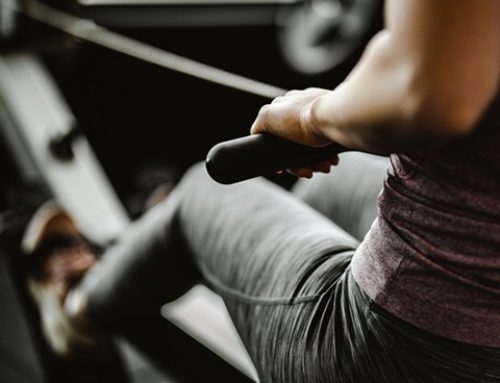Improve Your Endurance and Conditioning with a Heart Rate Monitor
Heart rate monitors have been around since the early 1980s. Nearly all cardio machines have one built into the handles. Now, heart rate monitors are a prominent feature on many smart watches, like the Apple Watch.
The technology is not new. Yet you don’t see many heart rate monitors adorning gym-goers’ wrists. If you do see someone wearing one, there’s a good chance he or she is trying to get an estimate of calories burned, which may not be very accurate.
However, a heart rate monitor is a valuable tool. It provides real-time data about how your body is performing. The key is to use that data to enhance your running or weight room workouts.
Heart Rate Monitors For Running
When you lift weights, you know exactly what intensity you’re working at, because you lift a specific amount of weight. But when you run, you probably just estimate the intensity of your workout based on how you feel. A heart rate monitor fixes this.
“People tend to have an inaccurate perception of workout intensity,” says Matt Fitzgerald, a highly sought-after coach of runners and triathletes and author of 80/20 Running: Run Stronger and Race Faster By Training Slower. “A heart rate monitor provides objective information about the intensity of your workout, which is one of the primary determinants of the benefits of your workout.”
That doesn’t mean going on a run to elevate your heart rate as much as possible. He says, “Putting on a heart rate monitor and looking at the numbers won’t necessarily do anything. You need to know what the numbers mean.”
You need to find your lactate threshold heart rate. This may sound like something you need a laboratory to measure, but it’s actually fairly easy to estimate. And no, your max heart rate is not appropriate as a baseline for your workouts, since it doesn’t factor in genetics, size and fitness level. It only takes 20 minutes or so to find your lactate threshold heart rate. Here’s how:
- Imagine intensity on a scale from 1-10, from absolute minimum exertion to maintaining the effort for only a few seconds.
- On a treadmill or track, start off at an effort of 1 for two minutes. You should be walking.
- Increase your effort level by 1 every two minutes.
- You reach your lactate threshold at six minutes. Measure your heart rate. You should be working at a comfortably hard pace.
- Repeat this two or three times until you feel you can zero in on your lactate threshold heart rate.
Based on this number, you can work in specific heart rate ranges designed to facilitate your training goal. Fitzgerald explains, “You can do workouts that are at a low intensity, below that lactate threshold, that are good for fat burning. You can do interval workouts where you go up to the highest intensity, [or you can do] tempo workouts where you dial in to that lactate threshold.”
This article focuses on the most common type of running workout: the unstructured jog.
Fitzgerald thinks that runners usually hit the same intensity every time and often work too hard. By using your lactate threshold heart rate, you can zone in on an intensity that is perfect for improving your general fitness without overdoing it. The key is to work at 81-89 percent of your lactate threshold heart rate.
So, if your lactate threshold heart rate was 160, run at an intensity that keeps your heart between 129 and 142 beats per minute (bpm).
“When you’re dealing with unstructured workouts, it’s better to actually dial it back a little bit,” he says. “You’ll get equal benefits with less stress on your body.”
Next time you go out for a run, wear a heart rate monitor. You should never guess when you train.
Heart Rate Monitors for Sports Conditioning
When playing team sports like football, basketball or hockey, you push your body to the limit every play, and you must recover quickly to be you’re ready for the next one.
According to Joe Neal, owner of 2SP Sports Performance (Madison Heights, Michigan), wearing a heart rate monitor during speed work allows you to precisely measure how quickly your heart responds to your drills, which should ideally simulate the demands of your sport.
Neal has his elite athletes perform drills such as 90-Yard Flys (30-Yard Jog, 30-Yard Sprint and 30-Yard Jog). He looks for a spike between 165 and 190 bpm, but the next set doesn’t start until the heart rate drops to about 130 bpm. He says, “It gives us real-time figures. We have athletes who think they are ready to go, but actually haven’t fully recovered.”
You can also use this data to measure if and how much your fitness is improving. “A faster spike and decrease in heart rate is a good indicator of fitness,” he says. To do this, simply time how long it takes your heart rate to return to 130 bpm. As your endurance improves, your heart rate will drop faster. When you’re on the field, you’ll be able to recover faster between plays.
Heart Rate Monitors for the Weight Room
You don’t see many folks wearing heart rate monitors while lifting weights. When building muscle size and strength, people follow set rest intervals so their muscles can recover. Let’s say you’re building max strength and need to rest for 3-5 minutes between sets. A heart rate doesn’t play much of a role in your recovery.
However, a heart rate monitor can be valuable if you’re performing a general fitness workout that’s designed with a muscular endurance and/or aerobic component. This type of workout consists of exercises performed for over 15 reps, or exercises paired in supersets or circuits so your body is constantly moving, such as a Hurricane Workout.
“It helps you make sure you’re actually working at your intended intensity,” says Neal. “A lot of people think they are working hard when they are really not. And some people might actually work too hard.”
In general, young athletes want to work between 165 and 190 bpm to challenge their bodies. When you’re recovering, you should expect your heart rate to lower to 130 bpm before you begin your next set. If your workout has a specified recovery interval, such as the Hurricane or a Tabata workout, keep track of how much your heart rate lowers during your recovery. The more, the better.
What If I Don’t Have a Heart Rate Monitor?
Wearing a heart rate monitor is the simplest way to attain this valuable information. But if you don’t have one, you can simply take your pulse. Place two fingers on the side of your neck and locate your carotid artery. Count the number of pulses over 15 seconds, then multiply this number by four to attain your beats per minute.
RECOMMENDED FOR YOU
MOST POPULAR
Improve Your Endurance and Conditioning with a Heart Rate Monitor
Heart rate monitors have been around since the early 1980s. Nearly all cardio machines have one built into the handles. Now, heart rate monitors are a prominent feature on many smart watches, like the Apple Watch.
The technology is not new. Yet you don’t see many heart rate monitors adorning gym-goers’ wrists. If you do see someone wearing one, there’s a good chance he or she is trying to get an estimate of calories burned, which may not be very accurate.
However, a heart rate monitor is a valuable tool. It provides real-time data about how your body is performing. The key is to use that data to enhance your running or weight room workouts.
Heart Rate Monitors For Running
When you lift weights, you know exactly what intensity you’re working at, because you lift a specific amount of weight. But when you run, you probably just estimate the intensity of your workout based on how you feel. A heart rate monitor fixes this.
“People tend to have an inaccurate perception of workout intensity,” says Matt Fitzgerald, a highly sought-after coach of runners and triathletes and author of 80/20 Running: Run Stronger and Race Faster By Training Slower. “A heart rate monitor provides objective information about the intensity of your workout, which is one of the primary determinants of the benefits of your workout.”
That doesn’t mean going on a run to elevate your heart rate as much as possible. He says, “Putting on a heart rate monitor and looking at the numbers won’t necessarily do anything. You need to know what the numbers mean.”
You need to find your lactate threshold heart rate. This may sound like something you need a laboratory to measure, but it’s actually fairly easy to estimate. And no, your max heart rate is not appropriate as a baseline for your workouts, since it doesn’t factor in genetics, size and fitness level. It only takes 20 minutes or so to find your lactate threshold heart rate. Here’s how:
- Imagine intensity on a scale from 1-10, from absolute minimum exertion to maintaining the effort for only a few seconds.
- On a treadmill or track, start off at an effort of 1 for two minutes. You should be walking.
- Increase your effort level by 1 every two minutes.
- You reach your lactate threshold at six minutes. Measure your heart rate. You should be working at a comfortably hard pace.
- Repeat this two or three times until you feel you can zero in on your lactate threshold heart rate.
Based on this number, you can work in specific heart rate ranges designed to facilitate your training goal. Fitzgerald explains, “You can do workouts that are at a low intensity, below that lactate threshold, that are good for fat burning. You can do interval workouts where you go up to the highest intensity, [or you can do] tempo workouts where you dial in to that lactate threshold.”
This article focuses on the most common type of running workout: the unstructured jog.
Fitzgerald thinks that runners usually hit the same intensity every time and often work too hard. By using your lactate threshold heart rate, you can zone in on an intensity that is perfect for improving your general fitness without overdoing it. The key is to work at 81-89 percent of your lactate threshold heart rate.
So, if your lactate threshold heart rate was 160, run at an intensity that keeps your heart between 129 and 142 beats per minute (bpm).
“When you’re dealing with unstructured workouts, it’s better to actually dial it back a little bit,” he says. “You’ll get equal benefits with less stress on your body.”
Next time you go out for a run, wear a heart rate monitor. You should never guess when you train.
Heart Rate Monitors for Sports Conditioning
When playing team sports like football, basketball or hockey, you push your body to the limit every play, and you must recover quickly to be you’re ready for the next one.
According to Joe Neal, owner of 2SP Sports Performance (Madison Heights, Michigan), wearing a heart rate monitor during speed work allows you to precisely measure how quickly your heart responds to your drills, which should ideally simulate the demands of your sport.
Neal has his elite athletes perform drills such as 90-Yard Flys (30-Yard Jog, 30-Yard Sprint and 30-Yard Jog). He looks for a spike between 165 and 190 bpm, but the next set doesn’t start until the heart rate drops to about 130 bpm. He says, “It gives us real-time figures. We have athletes who think they are ready to go, but actually haven’t fully recovered.”
You can also use this data to measure if and how much your fitness is improving. “A faster spike and decrease in heart rate is a good indicator of fitness,” he says. To do this, simply time how long it takes your heart rate to return to 130 bpm. As your endurance improves, your heart rate will drop faster. When you’re on the field, you’ll be able to recover faster between plays.
Heart Rate Monitors for the Weight Room
You don’t see many folks wearing heart rate monitors while lifting weights. When building muscle size and strength, people follow set rest intervals so their muscles can recover. Let’s say you’re building max strength and need to rest for 3-5 minutes between sets. A heart rate doesn’t play much of a role in your recovery.
However, a heart rate monitor can be valuable if you’re performing a general fitness workout that’s designed with a muscular endurance and/or aerobic component. This type of workout consists of exercises performed for over 15 reps, or exercises paired in supersets or circuits so your body is constantly moving, such as a Hurricane Workout.
“It helps you make sure you’re actually working at your intended intensity,” says Neal. “A lot of people think they are working hard when they are really not. And some people might actually work too hard.”
In general, young athletes want to work between 165 and 190 bpm to challenge their bodies. When you’re recovering, you should expect your heart rate to lower to 130 bpm before you begin your next set. If your workout has a specified recovery interval, such as the Hurricane or a Tabata workout, keep track of how much your heart rate lowers during your recovery. The more, the better.
What If I Don’t Have a Heart Rate Monitor?
Wearing a heart rate monitor is the simplest way to attain this valuable information. But if you don’t have one, you can simply take your pulse. Place two fingers on the side of your neck and locate your carotid artery. Count the number of pulses over 15 seconds, then multiply this number by four to attain your beats per minute.











